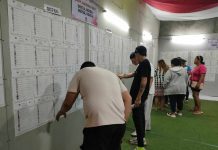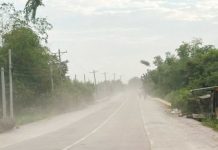ILOILO City – The National Irrigation Administration (NIA) Region 6 has assured that their irrigation systems and facilities are prepared for the upcoming El Niño phenomenon, expecting a substantial water supply to last until the end of the wet cropping season in February or March 2024.
Following a warning from the Department of Science and Technology (DOST) that about 65 provinces potentially face drought by May 2024 due to a stronger El Niño, NIA-6 has expressed confidence in its preparedness.
Danielle P. Pijuan, Public Relations Officer of NIA-6, said the current irrigation water supply is sufficient to last through this cropping season.
After the Philippine Atmospheric, Geophysical and Astronomical Services Administration (PAGASA) announced a likely El Niño phenomenon starting at the end of this year, potentially lasting until the second quarter of 2024, NIA-6 initiated an action plan.
This plan includes continuous monitoring of water levels in their dams to ensure enough water for irrigation across Region 6.
Despite projections of a stronger drought next year, Region 6, except for the province of Antique, is not expected to be severely affected.
Pijuan noted that with most rice crops in the region nearing harvest, the demand for water supply is reduced.
This factor, coupled with the water stored in 15 National Irrigation System (NIS) dams, reinforces NIA-6’s confidence in their water resources lasting until next year. These are the following:
* Suague River Irrigation System in Barangay Tolarucan, Mina, Iloilo (2,636 hectares or 1,728 farmers)
* Sta. Barbara Diversion Dam in Barangay Tungay, Santa Barbara, Iloilo (3,438 hectares or 1,282 farmers)
* Aganan River Irrigation System in Barangay Igtambo, San Miguel, Iloilo (4,863 hectares or 2,137 farmers)
* Jalaur River Irrigation System Diversion Dam in Barangay Moroboro, Dingle, Iloilo (9,481 hectares or 3,818 farmers)
* Barotac Viejo River Irrigation System in Barangay Rizal, Barotac Viejo, Iloilo (2,549 hectares or 1,100 farmers)
* Sibalom Diversion Dam in Leon, Iloilo (1,917 hectares or 2,312 farmers)
* Tipuluan Dam in Barangay Cubay, Sibalom, Antique (4,310 hectares or 3,163 farmers)
* Solong Dam in Barangay Solong, Sibalom, Antique (780 hectares or 821 farmers)
* Nasuli Dam in Barangay Solong, Sibalom, Antique (324 hectares or 350 farmers)
* Aklan River Irrigation System East in Barangay Sigcay, Banga, Aklan (2,288 hectares or 3,717 farmers)
* Aklan River Irrigation System West in Barangay Kinalangay, Malinao (1,983 hectares or 3,437 farmers)
* Panakuyan River Irrigation System in Barangay Agdungayan, Ibajay, Aklan (1,454 hectares or 1,561 farmers)
* Mambusao River Irrigation System Dam in Barangay Sinondojan, Mambusao, Capiz (1,423 hectares or 1,258 farmers)
* Bago River Irrigation System in Barangay Damsite, Murcia, Negros Occidental (12,971 hectares or 8,014 farmers)
* Pangiplan River Irrigation System Dam in Barangay Cabadiangan, Himamaylan City, Negros Occidental (1,840 hectares or 1,098 farmers)
Pijuan also said NIA-6 conducts annual rehabilitation and maintenance of its irrigation systems and facilities in March, April, and May, including desilting works to ensure uninterrupted water flow to canals and farmlands.
The irrigation systems are closed for maintenance from March 1st to April 30th each year, reopening on May 1st.
In anticipation of El Niño, NIA-6 has started distributing water pumps to farmers and installing solar water pumps in areas not reached by conventional irrigation systems. These solar water pumps, part of a sustainable climate adaptation project, represent a push towards renewable energy solutions.
Science and Technology Secretary Renato Solidum Jr. has observed that some effects of El Niño, such as reduced rainfall leading to dry conditions, are already being felt in parts of the country. He warns that by May 2024, 77% of the country’s provinces might experience drought, with 65 provinces facing potential drought and six provinces at risk of dry spells./PN





